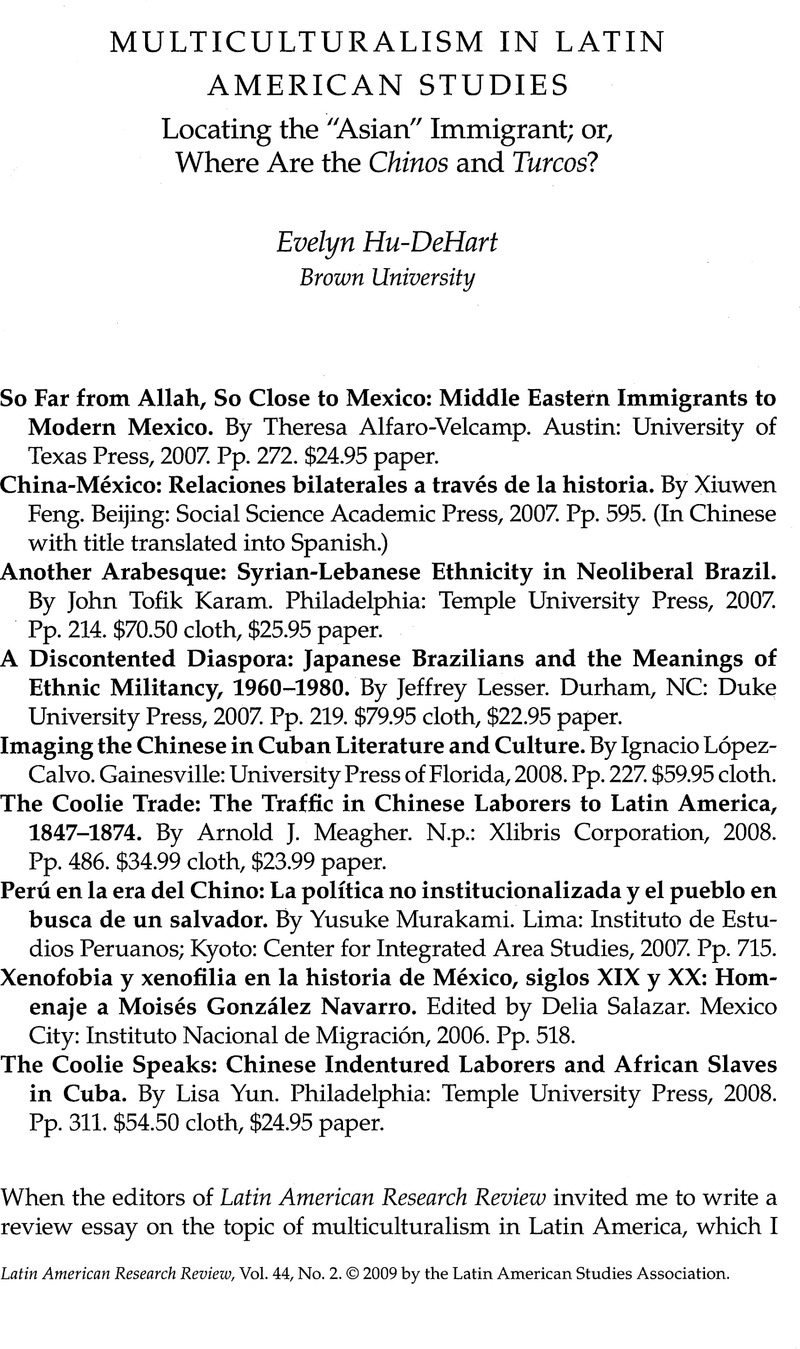Published online by Cambridge University Press: 05 September 2022

1. Carl Solberg, Immigration and Nationalism, Argentina and Chile, 1890–1914 (Austin: University of Texas Press, 1970).
2. Warren Dean, The Industrialization of São Paulo, 1880–1945 (Austin: University of Texas Press, 1969); Thomas Holloway, Immigrants on the Land: Coffee and Society in São Paulo, 1886–1934 (Chapel Hill: University of North Carolina Press, 1980).
3. Samuel L. Baily, ed., Mass Migration to Modern Latin America (Wilmington, DE: Scholarly Resources, 2003). Only one non-European immigrant group, the Japanese, merited its own chapter, while Italians and Spaniards received the bulk of attention; even the Danes had their own chapter.
4. José Moya, Cousins and Strangers: Spanish Immigrants in Buenos Aires, 1850–1930 (Berkeley: University of California Press, 1998).
5. Lok C. D. Siu, Memories of a Future Home: Diasporic Citizenship of Chinese in Panama (Stanford, CA: Stanford University Press, 2005); Diego Lin Chou, Chile y China: Inmigración y relaciones bilaterales (1845–1970) (Santiago de Chile: Ediciones de la Dirección de Bibliotecas, Archivos y Museos, Pontifica Universidad Católica de Chile; Instituto de Historia, Centro de Investigaciones Diego Barros Arana, 2004); Catalina Velázquez Morales, Los inmigrantes chinos en Baja California, 1920–1937 (Mexicali: Universidad Autónoma de Baja California, 2001).
6. The two Asian-trained scholars in this group, Feng and Chou, are ethnic Chinese but with very distinct backgrounds. Feng is based in Beijing while Chou is Taiwanese. Chou received a doctorate in history from the Universidad de Chile, and Feng received advanced training at Mexico's Universidad Nacional Autónoma de México. What their two hefty books have in common is close attention to what both term bilateral relations.
7. Daniel M. Masterson, with Sayaka Funaka-Classen, The Japanese in Latin America (Urbana: University of Illinois Press, 2004); Lane Ryo Hirabayashi, Akemi Kikumura-Yano, and James A. Hirabayashi, eds., New World, New Lives: Globalization and People of Japanese Descent in the Americas and from Latin America in Japan (Stanford, CA: Stanford University Press, 2002); Akemi Kikumura-Yano, ed., Encyclopedia of Japanese Descendants in the Americas: An Illustrated History of the Nikkei (Walnut Creek, CA: AltaMira Press, 2002).
8. Cuando Oriente llegó a América: Contribuciones de inmigrantes chinos, japoneses y coreanos (Washington, DC: Inter-American Development Bank, 2004). Available online in Spanish and Japanese on the Web site of the Inter-American Development Bank/Banco Interamericano de Desarrollo (www.iadb.org).
9. In addition to the collection Xenofobia y xenofilia already cited, see Rosa María Meyer and Delia Salazar, eds., Los inmigrantes en el mundo de los negocios (Mexico City: Instituto Nacional de Antropología e Historia, 2003).
10. Moisés González Navarro, Los extranjeros en México y los Mexicanos en el extranjero, 1821–1970 (Mexico City: El Colegio de México, Centro de Estudios Históricos, 1993). While not as openly acknowledged, there is also an implicit debt to the Japanese Mexican scholar María Elena Ota Mishima, who helped to pioneer immigration studies in Mexico. She is best known for two works: Destino México: Un estudio de las migraciones asiáticas a México, siglos XIX y XX (Mexico City: El Colegio de México, 1997), and Siete migraciones japoneses en México, 1890–1978 (Mexico City: El Colegio de México, 1982).
11. Jews as an immigrant category present certain challenges because they account for such a diversity of origins. There were Jews among Middle Eastern immigrants. However, most came from Europe and were therefore part of European flows. The study of Jewish immigrants has enjoyed a longer tradition in Latin American studies, enough to have made possible a book-length annotated guide published almost two decades ago: Latin American Jewish Studies: An Annotated Guide to the Literature, ed. Judith Laikin Elkin and Ana Lya Sater (New York: Greenwood Press, 1990). Since then, studies on Jews in Latin America continue to appear, including several essays in the collections edited by Salazar.
12. Actually, the term chino (or china) is even more complicated than just as a generic label for Asians. In the colonial period, it was one of the terms for a mixed-race person or casta. By the nineteenth century, it took on the additional meaning of a lower-class servant girl, and by the twentieth century, mi chinita referred to a sweetheart.